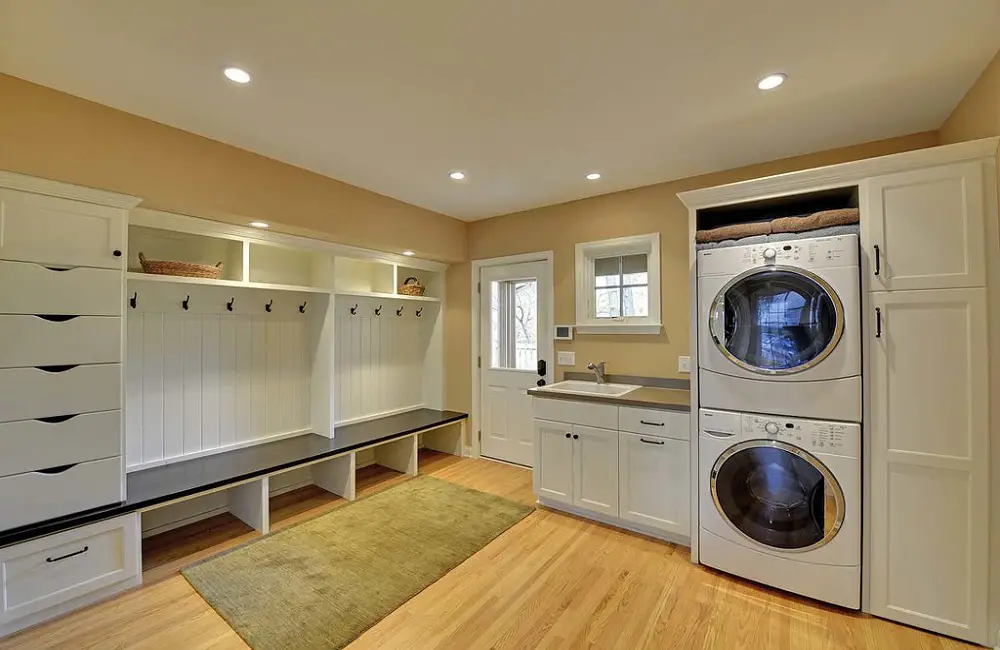One of the most popular architectural decisions made when building or renovating a home is to divide the laundry room from the bathroom. The positioning of these two areas may appear insignificant, yet it has a big impact on convenience, hygiene, and general household functionality.
Why then are the laundry room and bathroom usually located apart? Let’s investigate the motivations behind this architectural decision and find out the real story.
Historical Context
Examining past practices can help us understand why restrooms and laundry rooms are typically kept apart. Due to the labor-intensive and dirty nature of the chore, laundry was traditionally done outside or in a specialized washhouse, frequently away from the main living quarters.
In contrast, bathrooms have developed from public bathhouses to private indoor areas intended for personal hygiene. The separation of these sections was established as the standard due to the differences in their duties.
Hygiene and Sanitation
Hygiene is one of the main justifications for keeping the laundry and bathroom areas apart. Bathrooms are places where human waste is managed, which makes them breeding grounds for bacteria and bad smells.
It is possible for recently laundered objects to become contaminated if this area is combined with the laundry room, which is designated for cleaning garments and linens. By keeping clean clothes apart, germs and bacteria that could be found in a restroom are kept out of the laundry.
Moisture and Ventilation
Bathrooms are naturally damp spaces because of things like taking baths and showers. If left unchecked, excessive moisture can promote the formation of mold and mildew. Moisture is another issue in laundry rooms, mostly from drying garments and washing machines.
Combining the moisture from the two regions, though, can make ventilation extremely difficult. These areas can be kept apart to facilitate better ventilation and moisture management, which lowers the possibility of mold growth and preserves a healthier living atmosphere.
Noise Considerations
Washing machines and dryers in particular can produce a lot of noise. It is possible to isolate the noise and create a more tranquil and calm home by situating these machines in a separate laundry room.
Bathrooms are supposed to be peaceful areas for rest and self-care; keeping them apart from the noisy laundry machines contributes to the tranquil atmosphere.
Space Optimization
It makes sense from an architectural standpoint to divide these areas in order to maximize a home’s layout and usability. Bathrooms usually consist of a toilet, sink, shower, or bathtub, and other necessary fixtures in a small but cozy package.
The addition of laundry appliances to this area may result in crowding and decrease the bathroom’s usefulness. On the other hand, without sacrificing space or convenience, a specialized laundry room can be designed to fit washing machines, dryers, supply storage, and even places for folding or ironing clothes.
Plumbing Efficiency
From a plumbing perspective, keeping bathrooms and laundry rooms separate can simplify the installation and maintenance of plumbing systems. While both rooms require water supply and drainage, their specific needs differ.
Bathrooms need plumbing for sinks, toilets, and showers, which involve different types of fixtures and water usage patterns compared to laundry rooms. Separating the two allows for more efficient and targeted plumbing setups, which can reduce the likelihood of plumbing issues and make maintenance more straightforward.
Household Traffic Flow
Managing the traffic flow in the home is another pragmatic justification for this division. Every member of the household uses the bathroom frequently, and frequently at the same times, particularly in the mornings and nights.
It is possible to do laundry in a separate room without bothering other people who are using the restroom. This division can ease traffic and improve the effectiveness of daily tasks in the home.
Privacy Concerns
Bathrooms are private spaces where individuals expect a certain level of seclusion. Combining a bathroom with a laundry room could compromise this privacy, especially in homes with multiple occupants.
By keeping these spaces separate, it ensures that personal hygiene activities remain private, while laundry tasks can be performed without disrupting anyone’s privacy.
Practicality and Safety
Additional storage space is sometimes needed in laundry rooms for fabric softeners, detergents, and cleaning supplies—some of which might be dangerous if improperly handled. It is possible to have safer storage options when the laundry room and the bathroom are divided.
Additionally, it offers a dedicated space for jobs like folding, ironing, and organizing clothes—tasks that are impractical to complete in a restroom.
Modern Trends and Preferences
An increasing trend in contemporary house design is the creation of efficient and multipurpose living areas. Still, there is a strong preference to keep laundry and restrooms separate.
The need for optimal living conditions, convenience, and hygiene is what motivates this preference. Both designers and homeowners agree that creating a division between these two areas makes a house easier to maintain and more practical.
Conclusion
It’s not only customary to separate bathrooms and laundry rooms; this is a thoughtful decision that affects a home’s overall comfort and functionality. Homeowners can improve cleanliness, better control moisture and ventilation, minimize noise, maximize space, guarantee privacy, and ensure convenience by keeping these areas apart.
The long-standing preference for separation points to the useful advantages and improved quality of life that this architectural option offers, even though some contemporary homes experiment with mixing these rooms.
The next time you find yourself considering how to arrange your space, keep in mind that the decision to divide the bathroom and laundry area was made with consideration for hygienic practices, practicality, and careful design. It’s evidence of how little features in residential architecture may have a big influence on our day-to-day existence.

